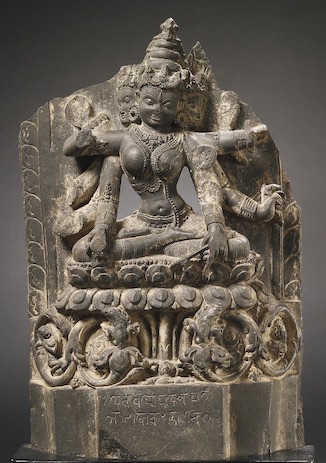
11th century, Eastern India, Tara, bronze with silver-inlaid eyes, private collection, photo on Sotheby’s
A rare and early bronze depicting (White?) Tara seated with her legs locked, holding lotuses in her left hand, the fingers making the refuge-bestowing gesture, and an egg-shaped object (probably a fruit or a jewel) in the other.

12th century, India, Tara, bronze with silver inlay, private collection, photo on Hardt
Equally unusual is this female figure holding a bowl in both hands. She has silver-inlaid eyes and a silver-inlaid necklace with a red gem pendant. The design of the lotus base and the mandorla recall another Tara, from Bengal, seen previously.

12th century, Northeastern India, Tara, bronze with silver, copper, and turquoise inlay, private collection, photo on Christie’s
Green Tara, seated with her right leg pendent, the foot placed on a large lotus stemming from the base, an open lotus in her left hand, her right hand dispelling fear. Very much in the Pala period tradition, her long dhoti is decorated with silver and copper discs and held in place with a heavy belt inlaid with turquoise. Her eyes and urna are inlaid with silver, her lips with copper.

11th-12th century, Northeastern India, Vajra Tara, stone, private collection, photo on Christie’s, Paris
This form of Tara normally has one head only. The above has three (or four ?) heads and eight arms (like a form of Yellow Tara). Her lower left hand clutches an arrow, the next one above seems to have held a bow. Her upper right hand holds a lotus, the lower one appears to hold a conch shell, associated with Vajra Tara (also called Vajritara).

What is the inscription on her plinth ?
LikeLike
Good question! The inscription on the plinth indicates the name of the donor, Gunamati, and according to the museum’s information ‘the creed is inscribed around the halo’ (not sure what they mean exactly). A note and the link to the website have been added to the post. Thank you for your interest.
LikeLike